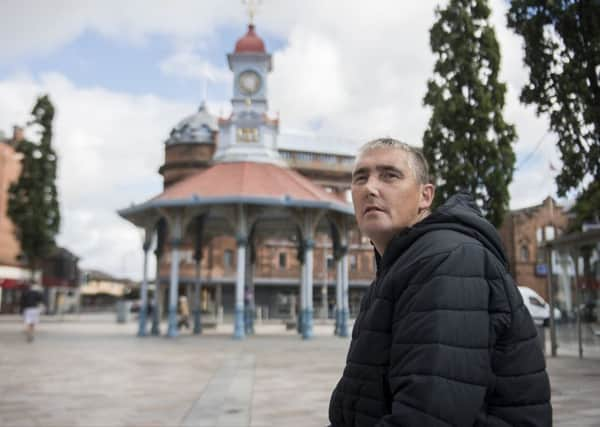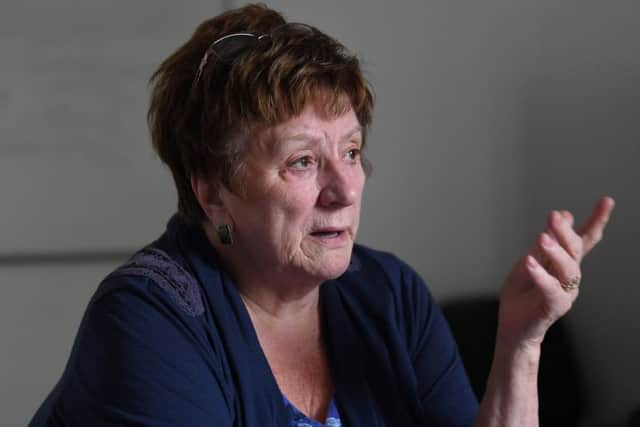Insight: Bridgeton fears yet another '˜poverty porn' TV show


Outside the Credit Union in Bridgeton, Glasgow, a group of boys stand swigging listlessly from cans of coke. Carved into the ground, close to their be-trainered feet, are the words: “The honest man though e’er sae poor/Is king o men for a’ that.” Though the boys pay it no heed, Burns’ egalitarian line is apt for a community which is trying hard to rise above the stigma of deprivation.
Across the road, the central column of the cast iron bandstand is draped in a union flag and faded flowers in memory of a recently departed Rangers fan. There, Jamie Docherty, 47, is talking about a contemporary, and less egalitarian, exploration of poverty: C4’s Born Famous. The reality TV series will pair the sons and daughters of “self-made” celebrities with teenagers from the less affluent areas their parents grew up in; thus they will gain an insight into the alternative lives they might have had if their parents had not become millionaires.
Advertisement
Hide AdAdvertisement
Hide AdDocherty has just found out that one of the episodes will feature Bethany Mone – daughter of the Ultimo bra tycoon and Conservative peer Michelle Mone, who was brought up in the city’s East End. “Is [Bethany] going to have to scrabble to find money for the electricity meter?” Docherty, a former plumber’s mate, who is unemployed, is asking. “Is she going to have to walk the six miles to Shettleston and back to sign on because she can’t afford the bus fare?”


Docherty is not the only one irritated by the show. In the past few days social media has been thrumming with indignation. Though C4 is pitching the series as “an exploration of social mobility”, many fear it will be an exercise in voyeurism.
“This is utterly despicable exploitation of a kind, close-knit community which has seen change led by local people,” tweeted Glasgow Central MP, Alison Thewliss. Lesley Ward, manager of Bridgeton Community Learners Campus, expressed her anger after a local charity was asked whether Bethany could be filmed handing out packed lunches to young people during play sessions. And comedian Janey Godley, herself a former East Ender, called the whole concept vulgar. “Michelle Mone is a Tory who voted against giving the poorest people decent living benefits and now wants to do a ‘Bridgeton Kardashian’ to give her daughter some air time,” she wrote.
This isn’t the first time the residents of the East End have had TV cameras foisted on them. Some remember the sense of betrayal they felt when Kay Carmichael, deputy chair of the supplementary benefits commission, went undercover in Lilybank near Tollcross, then made a TV series detailing her experience, back in 1977.
More recently, there was The Scheme, which followed the lives of troubled and often vulnerable residents in Onthank, Kilmarnock. The series won a Bafta, but turned Onthank into a byword for addiction and social disorder. After it finished, the estate became a tourist attraction with visitors coming from all over to look at the street in which drug user Marvin Baird, his girlfriend, Dayna, and his dog Bullet lived. Those who had starred in the series, and become tabloid fodder, struggled to adapt to life out of the spotlight. According to the Sun, Baird was hounded out of his new £350,000 home in North Lanarkshire. Earlier this year, he was jailed for dealing heroin.


East End residents also question the motives of Bethany, whose mother grew up not in Bridgeton, but gentrified Dennistoun. They wonder whether the programme will be anything more than a vehicle to raise the profile of the 18-year-old who recently posted pictures of her £770 YSL shoes on Instagram. Bethany hasn’t helped by describing herself as someone who loves to live in hotel dressing gowns; her mother hasn’t helped by describing Godley as “a moron”.
In a ground floor flat in neighbouring Calton, chair of Calton Area Association, Betty Cosgrove, sits primly behind a desk, a long to-do list in front of her. She has a look of wry amusement that says she has heard it all before. The look is directed at me because I have assured her I am not writing a piece that unfairly stigmatises the area. Cosgrove says many other journalists have told her the same.
Advertisement
Hide AdAdvertisement
Hide Ad“Someone took a photograph of a derelict building in the process of being knocked down and then another bright spark used it to say Calton was worse than Delhi for housing,” she tells me. “After that, I used to get phone calls from China and the US, people wanting to come over to see how, in Scotland, there was a place worse than Delhi. At first, I would take them out and show them the houses, all of which have been modernised.” But the visitors would keep demanding to see “the slums”. In the end, Cosgrove started telling them to make their own way round.
“I think [the media] use deprivation for their own ends – and everyone is fed up because we are doing our best, but you still get programmes like this,” she says.
Almost every journalist will have thought about how they write about poverty at some point in their career. It’s not always easy to strike a balance between exposing the inequalities at the heart of society and commodifying other people’s misery. Often reporters will be criticised for trawling the streets looking for anyone willing to talk; on the other hand, in my experience, third sector organisations sometimes act as gatekeepers to those who experience hardship, which, in itself denies them agency. The challenge is: how do you give vulnerable people a platform to speak without trading on their frailties or exacerbating their trauma?
Not every fly-on-the-wall documentary about poverty is wilfully exploitative. Kay Carmichael believed it was impossible to find out about poverty while sitting behind a desk. It was the controller of BBC Scotland Alistair Hetherington who persuaded her to use her experiences as the core of a documentary series. In his book, The Broken Journey, writer Kenneth Roy details how one tenant, Charlie McCrindle, alleged the BBC had bribed young people with cans of beer during the filming of that series, while city councillor Susan Baird said the programme had “degraded” the people of the estate. But many others believed Carmichael had done a service by exposing the conditions people were living in.
More dubious were a series of documentaries in which high-profile politicians spent a week living off benefits in one council estate or another. The first of these – a World In Action documentary, For The Benefit Of Mr Parris – saw a young Matthew Parris, then a Conservative MP, decamp to Scotswood in Newcastle, where his budget was £26.10 for the week.
Parris had claimed unemployment benefits should be kept low so that people were incentivised to work; now he was to test the theory. He lived frugally, cadged drinks from others, went to a football match, but still found himself out of cash before his time was up.
Filmed in 1984 – not long after the miners’ strike, when unemployment in Scotswood was 80 per cent – the programme was criticised for trivialising the problems former industrial heartlands were facing. Years later, Parris wrote he had learned that you cannot replicate “the spiritual desolation” of unemployment by trying it out it for a week. “‘Try all winter, try three months, try three years,’ the unemployed people I met told me, often angrily. ‘You descend from the London train, leaving your comfortable flat there and your nice house in Derbyshire, and your well-paid job in parliament, with all those subsidised bars; and you know that at the end of the week you can go back to all these things, and we can’t’.”
Advertisement
Hide AdAdvertisement
Hide AdThe programme was a launchpad for Parris’s career in journalism and TV. It attracted 13 million viewers. The wealthy toff vs working class oik formula was a success; and so it was replicated. In 2003, for example, Michael Portillo spent time pretending to be a single mother in Merseyside. And then Parris reprised his original role by going back to Scotswood to make For The Benefit Of Mr Parris Revisited in 2004.
Another “poverty safari” format which can be relied to pull in the viewers is the fly-on-the-wall documentary, as seen in The Scheme, Skint and Benefits Street. Given the drama lies in the conflict between the main characters, there was a temptation to home in on those who are the most dysfunctional.
C4’s Benefits Street, which aired in 2014 and included a demonstration of how to shoplift, gave the channel its highest ratings for any programme since 2012, but it also prompted hundreds of complaints to the media regulator Ofcom.
Four years earlier, The Scheme was similarly divisive. In a clash that highlighted some of the complexities of the debate, cultural commentator Pat Kane accused producers of turning the chaos of people’s lives into a cartoon strip, while broadcaster Stuart Cosgrove asked why it was OK for him to act up for the cameras and not the people on the estate.
Most of the criticism, however, focused on the negative way the estate was portrayed; a good deal of the programme wasn’t even shot in Onthank, residents said.
Go to Onthank (and neighbouring Knockinlaw) today and the resentment is still palpable. Residents are defensive when approached by reporters. “You’ll just twist everything,” they say.
Though no-one will reveal their name, stories about the impact of the filming do trickle out. I hear about the tourists who drove into Ardgour Place (where Marvin and Dayna lived) and peered in people’s windows.
Advertisement
Hide AdAdvertisement
Hide AdTensions developed between those who were filmed and those who weren’t and Marvin became a target for everyone who wanted to prove how hard they were. After the programme ended, he could sometimes be seen signing cigarette packets for a couple of pounds a shot.
There doesn’t seem to be any great physical legacy from Onthank’s 15 minutes of notoriety either. “While it was being shown resources poured in, though they disappeared soon after the cameras,” one man tells me. “That was the upside. The downside was the whole estate got a bad name. Even now, there are people who hear ‘Onthank’ and associate it with chaos and crime.”
Next to a shipping container on Morven Avenue, two women are sitting on a step drinking cups of tea. Both of them insist residents were misled about the kind of programme The Scheme would be. “At the beginning, they said they were going to focus on a woman who had just found out she was going to have a baby and follow her through her pregnancy,” the younger woman says. “They also claimed they were going to follow a couple preparing for their wedding. Positive stories, you know.
“None of that happened. Yet there are people here who go out to work every day – why couldn’t they have filmed them?” The woman, who did not feature in the series, says none of the promised facilities materialised. She calls a teenage boy to her side. “What is there for young people to do here?” she asks. “Nothin’” he replies.
One of the more life-affirming storylines in The Scheme revolved around the Cree family’s unsuccessful campaign to save the threatened Ardbeg Community Centre. After we have finished chatting, I walk to the small garden that now stands on the site.
The garden was designed by architect David Ross, who lived in Onthank as a child, and created with the help of The Beechgrove Garden. Ross had offered his services because he felt The Scheme misrepresented the estate.
Today, it is overgrown. An old mattress has been dumped at the entrance and a broken headboard lies on a path. Many of the flagstones are broken or missing; square, rectangular and hexagonal plant boxes are choked with weeds, though here and there a few stray violas have found a way through.
Advertisement
Hide AdAdvertisement
Hide AdIn Bridgeton, community leaders list the physical improvements to the area. They include the renovation of the old Olympia Theatre (now a library and boxing club) and the old Carnegie library (now the Glasgow Women’s Library) as well as the building of a new block of housing association flats.
In Calton, Betty Cosgrove talks about the community centre and the children’s and pensioners’ activities held in a cargo container. Outside, I pass the Calton Green Volunteers, who are trimming hedges. No-one wants to see this progress jeopardised by a TV programme.
Poverty is a complex topic; its roots are intractable and its effects far-reaching. As Darren McGarvey, author of the Orwell Prize-winning Poverty Safari, points out, there is no shortage of territory to mine. A good documentary could interrogate the link between Adverse Childhood Experiences (ACEs) and homelessness, violence and addiction. Or, as Ross suggests, the importance of empowering communities so that – after well- meaning projects like the garden are created – local people have the tools to maintain them. Alternatively, a good documentary could simply tell the stories of the lives of those who live in a community without turning them into the butt of some middle-class joke.
There are plenty of good documentaries. But McGarvey has little faith Born Famous is going to be one of them. “Instead, what C4 appears to be doing is sending two gold-plated wrecking balls into the East End of Glasgow where they will turn the UK’s most radioactive social problem into an episode of Comedians In Cars Getting Coffee,” he says. “For all the immense wealth that is likely to be on display this is as cheap and tacky as you can get.”
Let’s suppose for a moment Born Famous is a sincere attempt to get celebrities like Mone to “check their privilege”: is it likely to yield any insights? What the Parris World In Action shows surely demonstrated was that it is impossible to understand what it means to be poor by make-believing for a short period.
“I just fear [Bethany] is going to be like: ‘Look at me, I am so great, I have lived in poverty for, a week’,” says Claire Parkes. “Then she makes money on the back of that and in the process she ruins our community by bad-mouthing it. The problem is: once something’s said and out there, it cannot be taken back.”